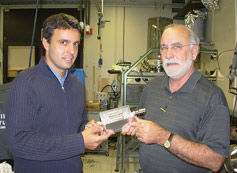
Handy Links
SLAC News Center
SLAC Today
- Subscribe
- Archives: Feb 2006-May 20, 2011
- Archives: May 23, 2011 and later
- Submit Feedback or Story Ideas
- About SLAC Today
SLAC News
Lab News
- Interactions
- Lightsources.org
- ILC NewsLine
- Int'l Science Grid This Week
- Fermilab Today
- Berkeley Lab News
- @brookhaven TODAY
- DOE Pulse
- CERN Courier
- DESY inForm
- US / LHC
SLAC Links
- Emergency
- Safety
- Policy Repository
- Site Entry Form

- Site Maps
- M & O Review
- Computing Status & Calendar
- SLAC Colloquium
- SLACspeak
- SLACspace
- SLAC Logo
- Café Menu
- Flea Market
- Web E-mail
- Marguerite Shuttle
- Discount Commuter Passes
-
Award Reporting Form
- SPIRES
- SciDoc
- Activity Groups
- Library
Stanford
Around the Bay
New Instrument to Help Catch Electron Clouds
 The International Linear Collider (ILC) will probe some of the deepest mysteries of the universe, but before that can happen, SLAC scientists must solve the puzzle of how to make the ILC run best. ILC Accelerator Physicist Mauro Pivi, along with collaborators from Surface and Materials Science
(SMS), PEP-II Accelerator Systems, Mechanical Fabrication and Power Conversion departments, are tackling an important piece of that puzzle—avoiding pesky "electron clouds," which could disrupt beam bunches in the ILC positron Damping Ring (DR).
The International Linear Collider (ILC) will probe some of the deepest mysteries of the universe, but before that can happen, SLAC scientists must solve the puzzle of how to make the ILC run best. ILC Accelerator Physicist Mauro Pivi, along with collaborators from Surface and Materials Science
(SMS), PEP-II Accelerator Systems, Mechanical Fabrication and Power Conversion departments, are tackling an important piece of that puzzle—avoiding pesky "electron clouds," which could disrupt beam bunches in the ILC positron Damping Ring (DR).
Electron clouds form and grow in beamlines with positively charged beams. Photons are released by the charged particles as they are turned by the bending magnets. The photons strike the vacuum walls of the beamline, knocking loose electrons, which can again strike the walls, creating more electrons. The electron cloud is trapped by the positron beam in the DR. Earlier this year, the collaboration investigated the behavior of electron clouds outside the bending magnets, in the PEP-II Low Energy Ring (LER). In 2008, they will investigate electron cloud behavior within magnetic fields.
In the upcoming electron cloud experiment, a chicane of magnets will subject the cloud to the same magnetic field as a DR bending magnet, while returning the positrons to the correct beam path after passage. Beam chambers instrumented with new analyzers to "sample" the energy and spatial location of the electrons in the cloud will be installed in the LER.
The analyzers, conceived and designed in SMS, are an elegant combination of nearly invisible fine grids and segmented metal collector stripes. Frank Cooper of SMS spent four months designing and shepherding the fabrication of the delicate analyzers. "I've been in this business a long time," Cooper says, "and this was the hardest thing to build." He had to wrestle with copper gratings half the diameter of a human hair.
The analyzers are positioned onto a 10-foot length of beam chamber prototyped to ILC DR specifications. The beam chamber vacuum wall texture is important for suppressing formation of electron clouds, so the collaboration will test four kinds of wall finishes, looking for the surface that generates the fewest electrons. "With bare aluminum walls you should see a lot of electrons going everywhere,” Pivi says. Coating the walls with titanium nitride makes it less likely to release the electrons that form the electron cloud when trapped by the passing positron bunches.
Earlier this year, grooved chamber walls proved to further decrease electron multiplication in regions free of magnetic fields. The electrons, Pivi says, get stuck in the grooves, where the passing beam can't reach them and fizzle out, so chambers with a coating and grooves will most likely also be the best with magnets. Recommendations will soon be made for the best wall finish to be used inside the ILC DR beamline.
—Amber Dance, SLAC Today, November 13, 2007
Above image: Mauro Pivi and Frank Cooper hold one of the analyzers that will help them understand electron clouds.